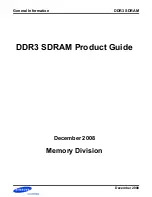
169
Note that delay of the
BACK
signal increases in units of approximately 0.1 ns/pF. (When a
capacitance of 220 pF is added, the delay increases by approximately 22 ns.)
BACK
SuperH
Microcomputer
C
Circuit with capacitor for eliminating spikes
c. Latching the
BACK
signal by using a flip-flop or triggering the flip-flop may or may not
be successful due to the narrow pulse width of the spike. Implement a circuit configuration
which will cause no problems when latching
BACK
or using
BACK
as a trigger signal.
When splitting the
BACK
signal into two signals and latching each of them using a flip-
flop or triggering the flip-flop, the flip-flop may operate for one signal but not for the other.
To capture the
BACK
signal using a flip-flop, receive the
BACK
signal using a single flip-
flop then distribute the signal (see figure below).
BACK
D Q
Q
D Q
Q
BACK
D Q
Q
Trigger OK
Trigger NG
8.11
Usage Notes
8.11.1
Usage Notes on Manual Reset
Condition: When DRAM (long-pitch mode) is used and a manual reset is performed.
The low width of
RAS
output may be shorter than usual in a reset (2.5 tcyc
→
1.5 tcyc),
preventing the specified value (t
RAS
) of DRAM from being satisfied.
Summary of Contents for HD6417032
Page 21: ......
Page 35: ...xiv ...
Page 85: ...50 ...
Page 101: ...66 ...
Page 129: ...94 ...
Page 135: ...100 ...
Page 343: ...308 ...
Page 369: ...334 ...
Page 383: ...348 ...
Page 475: ...440 ...
Page 525: ...490 CK RAS CAS TRp TRc TRcc tRASD1 tRASD2 tCASD3 tCASD2 TRr tCSR Figure 20 18 Self Refresh ...
Page 578: ...543 CK RAS CAS TRp TRc TRcc tRASD1 tRASD2 tCASD3 tCASD2 TRr tCSR Figure 20 62 Self Refresh ...
Page 689: ...654 ...
















































